Stinque Recipe Challenge
So tonight we’re going for the gold – Sole Meuniere (the dish that turned Julia Child on to French food), haricot vert (in this case, French green beans from Fairway), and pommes de terre (here Potatoes Lyonnaise). First, the potatoes, because they can be made ahead and reheated. The finished dish:
INGREDIENTS
3 Tbsp butter
2.5 cups thinly sliced onion
6-8 boiling potatoes, sliced thin (the French peel them, but I went Galt and didn’t)
salt and freshly ground white pepper
1 cup coarsely grated Swiss cheese
1.5 cups chicken stock (I simmered 4 cups down to 1.5 to concentrate the flavor)
Got a Swiss-made mandolin today at Zabar’s (anything to buy a new kitchen gadget) so let’s employ it to slice up the onions:
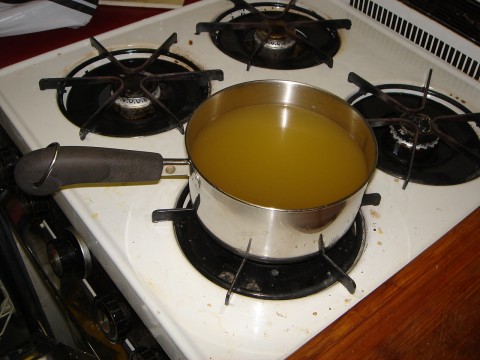 First I took 4 cups of chicken stock down to about 1.5 cups, to concentrate the flavor.
First I took 4 cups of chicken stock down to about 1.5 cups, to concentrate the flavor.
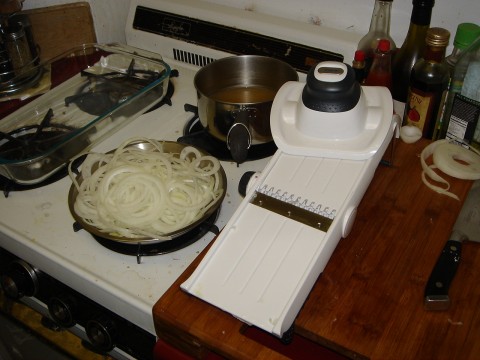 Mandolin worked well but for the small tip of a finger I lost (my bad). Onions go in …
Mandolin worked well but for the small tip of a finger I lost (my bad). Onions go in …
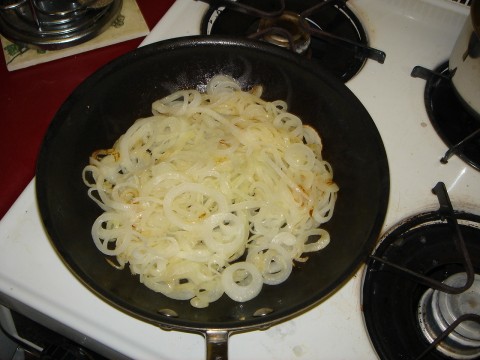 Looking good, so let’s slice up the potatoes:
Looking good, so let’s slice up the potatoes:
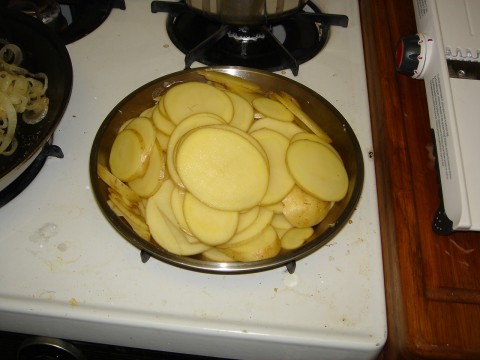 Buttered Pyrex with first layer of potatoes:
Buttered Pyrex with first layer of potatoes:
Swiss cheese blitzed in the food processor:
First layer of potatoes, onions, and swiss – do 3 layers, and use more cheese on last layer, then dump the reduced chicken stock in (don’t pout ir over the top) and place in 450 oven for 15 minutes, then reduce to 325 for 45 minutes, and cool on a rack:
Next dishes done shortly:
The string beans (haricot vert) are simple – saute them in olive oil, salt, and pepper, then add sesame oil for the last 10 seconds:
As for the fish:
- Petrale/ Dover sole fillets
- salt and fresh-ground pepper
- all-purpose flour
- 45g (3 tablespoons or 1/2 stick minus 1 tablespoon) unsalted butter, plus 15g (1 tbsp) for later
- half a lemon
Make sure the fillets are thoroughly thawed. Season very lightly on both sides with salt and pepper.
In a skillet over medium-low heat, melt the 45g butter. As soon as the butter stops foaming, dredge both sides of each fillet lightly in flour; slap the fish around to get rid of as much excess flour as you can. Lay them out on the pan, being sure not to overcrowd the pan (maybe 3 fillets at a time). Cook for 3-5 minutes (5 minutes if you had thicker fillets like I did, but it really won’t take long especially if you thawed them well), turning once during cooking. Drain the fillets and lay them out on the serving platter. Melt the additional 15g of butter into the now-browned butter in the pan and turn off the heat. Squeeze the lemon into the pan and stir together well. Pour the sauce over the fillets.
I forgot the lemon, but it was delicious anyway. And remember – when Julia ate this dish for the first time, she ate it in a restaurant founded in 1345.
Et voila!
I thought you did this one with the potatoes.
Looks good. All that butter… Actually, I prefer the French way of food. Small quantities of quality over massive quantities of dubious quality which is why I’ll buy premium booze and expensive ingredients instead of going for the bulk cheap stuff (unless I really need it.)
My housemate does it the other way. Consume mass quantities of dubious quality which helps explain why he’s almost 300lb (!!) and in very poor health.
Inspired by this, I’m going to try something different tomorrow. I’m going to try for pan fried Salmon with wine sauce because I have 1/2 a bottle I used for cooking chilli last week kicking around. I’m not very good with sauces so this might just end up to be pan fried Salmon.
@ManchuCandidate: Do some googling and figure out the best way to braise in butter and add wine. and maybe dredge in flour at some point ….
Mmmmm … that looks so delicious! That is my favorite way to do green beans.
Wow this smells great from here. Do people in your apartment dry hump your door and shit when you make these meals?
@FlyingChainSaw: Some of the people on my floor were commenting on the scent in the hall when I made a tagine. So good.
@blogenfreude: Watch out they don’t rappel into your kitchen window and pounce you!
Did you see my slow-roasted cherry tomatoes?
They are so good!
@Manchu: Don’t fry salmon, that’s an insult to the fish. Grill it.
@Karen: tomatoes done that way are simply heaven on earth.
@Bloggie: You could have stopped at those potatoes of butter and crack and scored a perfect 10.
I should post my recipe for the .308 and .30-30 rounds I’m making up these days.
@blogenfreude: Oh, yeah — do you have an independent thermometer for your oven temperature? I think your oven may run hot.
@karen marie: No, and I think you are right … tend to dial it down about 25 degrees from recommended temp, but sometimes I forget. The potatoes were incredible though.
I figured out why I suck at sauces. Lack of patience especially when I’m hungry so I started to make the sauce first.
Made red wine sauce to put on grilled salmon steaks.
For such a simple recipe, it was a lot of work. Reducing the wine and orange juice took a long damn time. Allowed me to use a sauce pan I got as a house warming gift. Sauce pan? Yeah, I guess the person who gave it to me thought I would improve as a cook instead of hitting the nearest Wendys or Falfal place.
It could be better, but it is a first time and I’m not well versed in the tricky nature of sauces.
Bravo, Bloggie. You crowded that fish when you sauteed, but I could see from the foam it was not harming anything. But really, seriously, not overcrowding a pan when you are suateeing or browining is the thing to really internalize, you want an inch between pieces, any time you are browning or sauteeing. Get yourself a huge saute pan, if I were sauteeing 3 portions of fish, I would use my biggest, no shit. If that wasn’t thin filets of flatfish, you woulda had trouble, moisture from the fish, and all that.
Please, my friend, don’t focus on “recipes,” focus on techniques and themes. The potato dish, don’t view that as a “recipe,” view that as a technique. Its Potatos Anna, the most basic form, which is the haute cuisine version of scalloped potatoes, sliced potatoes baked with butter, maybe cream, bakes slowly, slowly, its one of the most divine flavors on earth, sliced potatos made into a casserole and slowly baked, the combo of butter and potato, the simplest version, Potatos Anna, is the master recipe. Master the master recipe, after that, every other recipe is a simple variation. Add cheese, yay! Add goat cheese, and you have your own unique goat cheese potatos anna, alternate thin slices of eggplant between the slices of potato, ohmygod, its starting to turn into potato lasagna. Add pork in some form, ham, prosciutto, bacon, Ohmygod, another level of flavor, and calories. Garlic, shallots, leeks, ohmygod, think of this one, the potato slices, interweaved with thin-sliced leeks, and butter, cream, salt and peppper, its a casserole version of leek and potato soup, also known as vichysoisse, when served cold. Or, holy shit, the traditional ingredients of New England clam chowder, its just potatos, onions, clams, salt pork, butter, and half-and-half. I’m just wandering here, could you do a clam and potato and onion version, that would taste like a chewy version of New England Clam Chowder, deconstructed and put back together in a different way? I have come close to this with a version of stuffed clams, in which the clam, served whole in one of its shells, like clams casino, except the topping was a concentrated version of new england clam chowder, a thick creamy mix of potatoes and onion and some crispy-fried little bits of salt pork.
But you see, thats why you should never focus on recipes, you should focus on techniques and themes, and then its so easy to just vary the theme, while keeping true to the technique, and you are writing your own recipes.
Goat cheese, by the way, loses some of its sharpness, when used in a casserole as I suggested, and it results in a very “light” mouthfeel, not so heavy, rich, and dense, as is the case with most other cheeses. This holds true through most recipes, involving cheese, a goat cheese ceasar, for example, is much “lighter,” fresher, livelier, than a traditional ceasar salad. See, there, Caesar salad is not a recipe, its a technique, from which you create your recipes, by introducing variations, switching goat cheese for the parmesan, for one example. Make a ceasar with Humboldt Fog, that would be divine, wouldn’t it? Back off on the lemon and anchovy and garlic on that one, you are wanting to taste that cheese. For that one, you will want a very special crouton. There is where you can get reallky creative. Deep fry some cooked, buckwheat udon that you have spiced with thai curry, there is an amazing texture, when you deep fry a thick noodle like udon, it gets a crispy skin, but its still a luxurious chewy udon noodle inside, throw some crispy-fried udon noodles on that Humboldt Fog ceasar, instead of garden variety croutons, its ceasar salad, but its not, its different. Make it with endive, instead of romaine, oh man, what a luxurious salad that would be, Humboldt Fog ceasar endive, with crispy-fried, thai-spiced, udon noodles.
I just made that up, you understand, thats the beauty of thinking in terms of techniques and themes, you don’t just learn to make ceasar salad, you learn the parameters of the stage on which you can then perform.
@Promnight:
before I did that food, I did a few things that had no recipe. I used my Flavor Bible (or ignored it) and made food that did not obey the law. I am better for it ….
Mad Men moratorium in effect? All I gotta say is holy shit. I liked that guy from the Goldwater campaign. Bet they never saw “Daisies” coming.
@redmanlaw: Till at least Monday night. And you can tell we’re nearing the end of the season when the shit starts piling up.
Not wishing to sound remotely critical but I’m with Prom on this and it’s the reason I distrust Julia Child (and hated that movie). Her book is essentially about recipes not food. Some of the recipes are very good but both of her collaborators, in my opinion, wrote more interesting and useful books. Elizabeth David writes about food and how to approach the useful task of teaching oneself how to cook it. Her books also stand as literature of a kind, they are fascinating to read. For example, she provides a method and recipe for a classic chocolate mousse that is, if you like that sort of thing, incomparable. Simple, easy and exacting. But, and this is where she is always interesting, she remarks that the tastes of chocolate and orange are very similar and so she adds a teaspoon of Cointreu to deepen and enrich the taste of the final dish. One eats and thinks.
In my estimation, meuniere is a restaurant technique that is really hard to duplicate at home though one can get close. But as I understand it it’s about floured fish gently sauteed in the best butter money can buy into which, when the fish is cooked and set aside on a warm plate, one squeezes a generous slice of lemon stirring it briskly into the hot butter and residue of cooked flour. The result is a great frothing foam which lasts a very brief moment and is why I say it’s restaurant food. The next step is to fillet the fish, set the fillets on warm plates, spoon over the still-foaming butter and place the whole thing before the diner still seething. It is a thing of great beauty and hard to pull off. I had it once in Grenobles after a hare terrine that tasted like chocolate it was so rich. It was served by madame who filleted the trout (I’ve only known it done with trout) with two spoons in a display of skill and nonchalance that haunts me to this day, set the fillets on the plate and put it before me as if it were the most banal act imaginable. I don’t think I actually cried but it’s possible. It’s a very good dish with trout. I personally don’t think Dover Sole worth the money unless you get them fresh from the water round Dover. There were always local flat fish I liked more. But Prom is right about the technique. I had sand dabs in Sausalito that were essentially served au meuniere, though without the lavish skill of the Franch as regards the service.
I used to make a potato gallette that was very good and was essentially an older form of pommes dauphinoise, ie, without all that cream. I never much like cream in food if I can taste it. I don’t mind it in the background but not when it’s all gloppy and slopping about. As I remember the potatoes were sliced very thin, soaked in water, dried very thoroughly and packed lightly into a sautee pan and cooked slowly in butter. Halfway through cooking one flips the gallette so that it gets a rich crust on both sides while the potatoes are melting inside. it is set on a board and cut like a cake. I used to make that a lot and it’s sensational, all things being equal. I think I learned how from Richard Olney’s Simple French Food which was my favorite book. He really teaches the techniques and then applies them to food in ways that are totally surprising. He has a way of poaching soufflees and then baking them that is one of the most delicious dishes I ever cooked. That and his way of boning a char through its back, stuffing it and sewing it up before baking, were the dishes I cooked most from that book.
But good food. mon brave, and what a great way to spend Sunday. Alors.
@Benedick Arnuldsson Manpants: Recipes are a start – very few can see a meal when viewing a pile of ingredients. I have cooked a lot w/ my Flavor Bible, but I also use, and abuse, various recipes. I was reared by Hebrews, not the French, so I need some direction. So I challenge you – cook Julia’s chicken fricasse, then tell me the recipe is not useful.
And you are close by! This fall, we shall have you over for dinner, and I will make the sole meuniere. It will give me an excuse to buy a new pot.
I would simply not cook / bake were it not for recipes. It’s like bloggie said — very few can see a meal (or pie!) when viewing a pile of ingredients, and I sure ain’t one of them.
@Benedick Arnuldsson Manpants: when you speak of sole meuniere, you are thinking of the whole fish sauteed in butter, then skinned and fileted at table, in what is one of the most wonderful examples of amazing service, when done correctly, and its also the sole (haha) legitimate use for the fish knife, which is designed to lift and seperate (like a playtex bra) the filet from the bones.
I think it is legitimate to consider the julia child recipe as authentic, in which one sautes skinless filets in butter, first dusting them with flour. But its a different texture and taste experience, the flour-dusted filet has a slight crunch, and when you filet a whole fish, the butter picks up the flavor of the fish’s skin, which imparts a meaty flavor, which will be absent if you just saute filets. But it is much easier to serve multiple orders of the sauteed filets, and can be done at home. The strict “no crowding” rule will require sauteeing the filets in shifts, and its important to keep them warm and dry while waiting to make the sauce and serve, and you will need to have an oven at 150 or so, and place them on paper towels, to absorb any moisture which seeps out.
Professional kitchen equipment is a whole nother world from the typical, even the high-end, home appliances, and its difficult to make many dishes come out exactly as they would in a restaurant, at home, but it can be done, its just laborious, you have to engage in Rube-Goldberg like equipment improvisations and such to recreate the effect of the professional equipment, and I think it might be impossible if you have never worked in a professional kitchen and have a visceral feel for the difference, and the effect you are trying to recreate. The biggest differences are first, sheer heat intensity, a professional range, broiler, and oven, these things are capable of sooooo much higher temps. The second thing is the size of the pans. A standard size home saute pan is capable of producing only one portion at a time, and in a professional kitchen, each order of sole meuniere would be cooked in its own individual saute pan, each the size of what would be the average home’s largest frying pan. I worked a saute station in one restaurant that had 24 burners, and when we were cranking, I would be sauteeing 24 individual dishes in 24 pans, at once. You had a buspan to put the dirty pans in, and the potwasher shuttled back and forth, taking the dirty pans away and bringing back clean ones. You can only keep that up for a few hours, its a workout, and then you must get very drunk. We kept 5 gallon buckets of ice water behind the line, and we soaked towels in them, and periodically grabbed a towel and gave ourselves an icewater shower, putting the towel on your head and letting the ice cold water stream down over your face and chest. The temperarture behind the line often came close to 12o degrees, but it was joyful work, to me, just handling it, putting things out that you know were “right,” so much pride in that, more so for the near-impossibility of the task, at that pace.
You simply cannot explain in words, what “sauteeing” is, without being able to show someone. You have to see it, to sense just how hot the butter must be, just how quick the whole thing is, when done at those temperatures. Sole, or flounder, meuniere, is 3 minutes, if that. yet you must also have the temperature just perfect, so as not to burn the butter. On that 24 burner station I had, the burners were set and left on. No time to regulate them when you were cranking. Thats why I stress the “don’t overcrowd” thing so much, the only hope that a home range and a home pan will stay hot enough, is that you don’t try to cook too much at once.
The best introduction to learning sauteeing, is to learn to fry a perfect fried egg, because frying an egg is the only form of sauteeing that most people do right.
Whats a perfect fried egg? well, its slightly browned, and crispy, on the outside, but it must be fried quickly enough that the interior is not overcooked, so it does not become rubbery. The edges of the egg should form a crisp, light brown “lace,” you know what I mean, its delicious, that fringe on a properly fried egg. And you know what it sounds like to properly fry an egg, there is a sound, as you crack the egg, and pour it in the pan, and it bubbles and cracks hisses and “jumps” as it starts to cook, and thats what “saute” means in french, “jump,” referring to the food skittering on the hot surface, never just sitting on the surface. And everything about frying that perfect fried egg is exactly what you want to see and hear when you saute anything. Any liquid that seeps from the food must skitter and instantly evaporate, it cannot ever be allowed to sit and slowly boil off.
From sauteeing, you get to pan-broiling, and pan-roasting, similar, but different, techniques, difficult, I have not mastered them, but pan-roasting a chicken thigh, results in something indistinguishable from the best roast duck you ever had, but for pennies. Pan-broiling, or something right between pan-broiling and sauteeing, is my favorite with thick, meaty white fish, grouper and halibut. You use a lower heat, so that the interior cooks before the outside gets burned, but still, you must make sure, no liquid get involved, no liquids seep from the food and turn it the process into boiling or steaming the food.
@blogenfreude: I’ll bring you ED. And try to find Olney.
@Promnight: I have to go to bed now so I can be up early and at my desk. Not all of us can afford to keep attorneys’ hours: 11:30-3. So I’ll read your post in the AM. Nighty night.
I want to give one big tip, gigantic pans are actually quite cheap in restaurant supply stores, go there and get a 24 inch saute pan. Get stainless, with an aluminum bottom, never ever teflon coated. Stainless actually gets seasoned with use, if you don’t scratch and scour it too much when cleaning. Most important, with stainless, always heat the pan quite hot, before adding anything, even the oil or butter, the heat makes the metal expand and closes the microscopic cracks in the surface, and things will not stick, if you heat the pan through, to full cooking temperature, before adding anything at all. Anything that does stick will come off without scouring, put the still hot pan under the faucet and let it boil off, and don’t scour and scrape, thats how you get a stainless pan seasoned. Yes, when you put it away, it should still be slightly greasy feeling.
@mellbell, blogNfreud, prom: I’m from the “learn some technique and be able to throw stuff together” school. None of my stuff would be called “high tone” or anything, though.
@redmanlaw: To me, the highest “high tone,” is fresh, good stuff, cooked just right. Your stuffed jalapenos looked right to me. My home area, our local products are quahog clams, and blueclaw crabs. I can buy clams from the dock where the clammers bring them in, when I can’t get out to dig my own. The smallest of them are called littlenecks, slightly larger than a quarter. There are two ways to cook them: 1. steam them. 2. Just throw them on a barbecue grill till they open up, having cooked in their own juices. Dip them in butter and eat them, there is nothing better.
Its not haute cuisine to think, “hey, when I steam them, I am gonna throw in a handful of chopped garlic, a handful of chopped parsely, and a cup of white wine. Its still just as simple as making a bowl of cereal.
The blueclaws, the best, the highest, divine form, is softshells, and they are regarded as damn near caviar in the pantheon of food delights, but I am lucky to live where I can buy them off the dock, alive. And they are best, simply sauteed, dredge in flour, fry in butter, like an egg. They need nothing more, they are a true miraculous delight, a higher perfection than anything you spend $100 on in the French Laundry.
fresh, local, and simple, thats the highest cuisine.
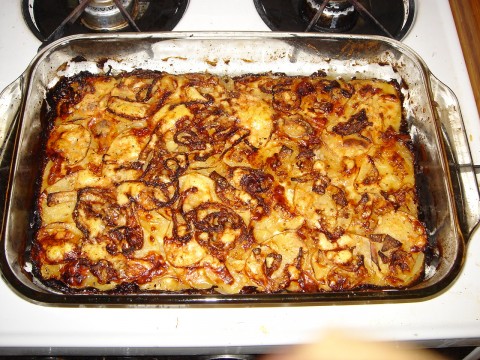
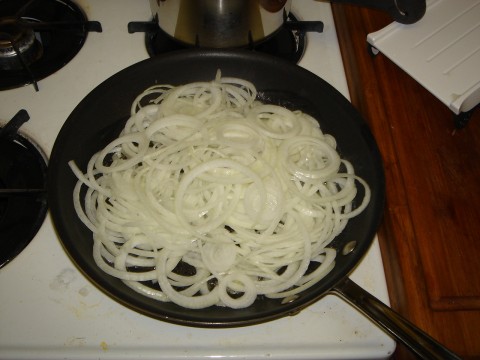
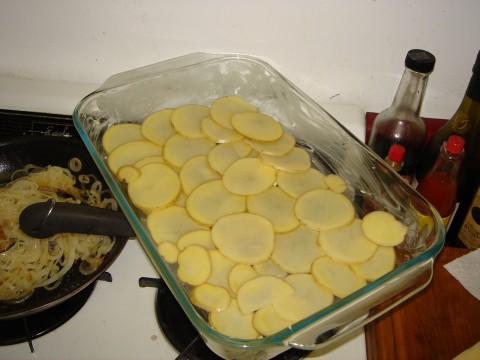
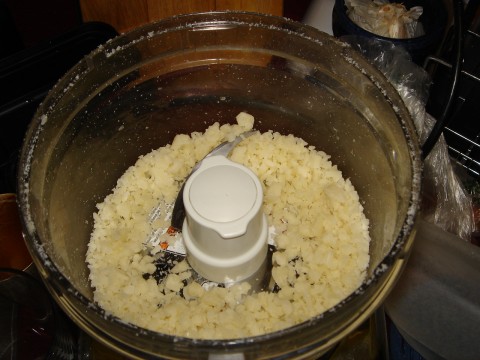
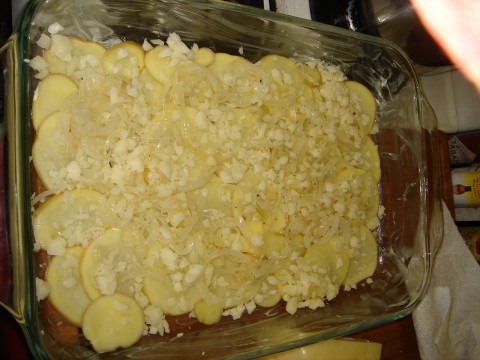
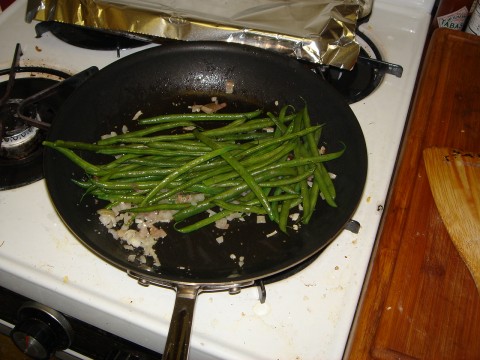
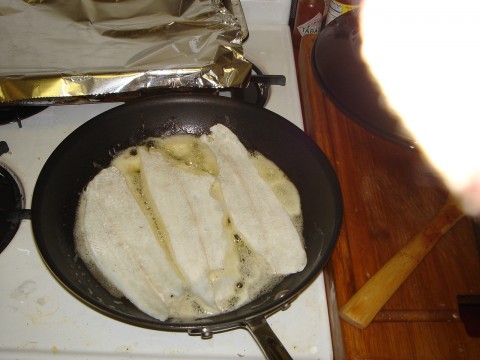
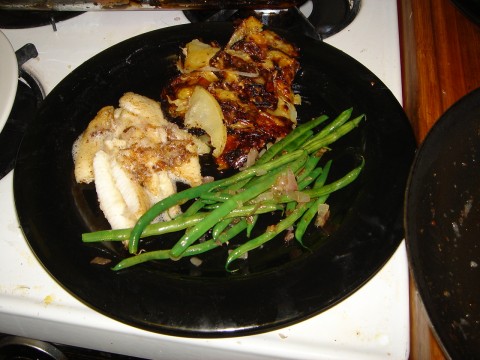
NOJO • Nightmare at the Museum From the last time he threatened to bomb Iran, 2020. Remember that one? All a misty blur now.
NOJO • TRUMP TARIFFS UNLEASHING FURY OF CANADIANS - AND THEIR LEGENDARY SNIPERS! @ManchuCandidate: I have birthright citizenship in Cascadia, so I think I’m good.
MANCHUCANDIDATE • TRUMP TARIFFS UNLEASHING FURY OF CANADIANS - AND THEIR LEGENDARY SNIPERS! @nojo: Only the sane parts... like the West coast, New England (minus the Bruins and…
NOJO • TRUMP TARIFFS UNLEASHING FURY OF CANADIANS - AND THEIR LEGENDARY SNIPERS! @ManchuCandidate: So, can you guys annex us now?
MANCHUCANDIDATE • TRUMP TARIFFS UNLEASHING FURY OF CANADIANS - AND THEIR LEGENDARY SNIPERS! PP is done. 51st state, my ass.
NOJO • TRUMP TARIFFS UNLEASHING FURY OF CANADIANS - AND THEIR LEGENDARY SNIPERS! @FlyingChainSaw: No, but my government was.
FLYINGCHAINSAW • TRUMP TARIFFS UNLEASHING FURY OF CANADIANS - AND THEIR LEGENDARY SNIPERS! @nojo: Were you kidnapped?
NOJO • TRUMP TARIFFS UNLEASHING FURY OF CANADIANS - AND THEIR LEGENDARY SNIPERS! @FlyingChainSaw: I’ve spent the past five weeks looking like Astronaut Dave going through the…
FLYINGCHAINSAW • TRUMP TARIFFS UNLEASHING FURY OF CANADIANS - AND THEIR LEGENDARY SNIPERS! NOJO - HOW COME WE'RE NOT COVERING KRASNOV?
NOJO • The Reckoning Four years later: Uhhh, how’d that work out?